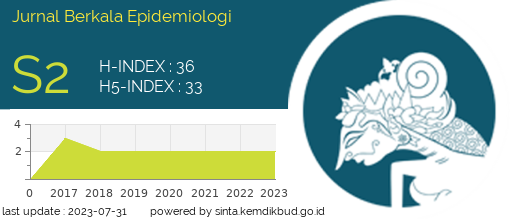Environment Biological and Health Care Efforts Influenced of Lymfatic Filariasis Incidence, Sarmi Distric
Downloads
Sarmi District is the most endemic area of filariasis in Papua which has rate of microfilaria (mf) (47.06%) up to the year 2012. In the Province Papua filarial worm is Wuchereria bancrofti and is transmitted through the bite of a mosquito vectors. Lymphatic filariasis does not cause death, but in chronic cases it causes disability, psychosocial problems, stigma, and decreased productivity. This study was aimed to analyze environment biological and health care efforts that influence the incidence of lymphatic filariasis. This study used case-control method. Samples comprised 32 case samples (mf +) and 32 control samples (mf-). Primary data were collected through interviews and observation. Data were analyzed using Chi-Square and continued with multivariate Logistic Regression. Statistical analysis obtained indicated two variables on the incidence of lymphatic filariasis limfatik in District Sarmi (health care efforts p-value = 0.002, OR: 7.779, as well as the biological environment p-value= 0.008, OR: 5.841). Significant variables were health services with sub-variables promotion, prevention and the environmental biology. Suggestion: Mosquito bites should be avoided, the vector should be controlled through mutual cooperation and health promotion should be implemented.
Achmadi Umar F. 2013. Kesehatan Masyarakat Teori dan Aplikasinya. Jakarta: PT. Raja Grafindo Persada.
Departemen Kesehatan RI. 2005. Lampiran Keputusan Menteri Kesehatan Nomor 1114/Menkes/SK/ VII/2005 tentang Pedoman Pelaksanaan Promosi Kesehatan di Daerah.
Departemen Kesehatan RI. 2007. Ekologi dan Aspek Perilaku Vektor. Jakarta: Dirjen PP dan PL.
Dinkes Provinsi Papua, 2012. Data P2M, Kabid P2M & PL, Pemberantasn Penyakit Filariasis, Provinsi Papua.
Harijanto PN. 2000. Malaria, Epidemiologi, Patogenesis, Manifestasi Klinis dan Penanganan. Jakarta: Buku Kedokteran.
Ike Ani W, Suhartono, Nurjazuli. 2013. Hubungan Kondisi Lingkungan, Sosial Ekonomi dan Perilaku Masyarakat dengan Kejadian Filariasis di Kecamatan Pekalongan. Jurnal Kesehatan Lingkungan Indonesia; 12 (1).
Kemenkes RI., 2010a. Rencana Nasional, Program Akselerasi Eliminasi Filariasis di Indonesia Tahun 2010–2014, Subdit Filariasis dan Schistomiasis. Jakarta: Direktorat P2B2 Ditjen P2 & PL.
Kemenkes RI. 2010b. Filariasis di Indonesia. Buletin Jendela Epidemiologi; 1: 1–28.
Kemenkes RI., 2011. Promosi Kesehatan. Panduan Bagi Petugas Kesehatan di Puskesmas. Pusat Promosi Kesehatan, Jakarta.
Kalangi Nico S. 1994. Kebudayaan dan Kesehatan, Pengembangan Kesehatan Primer Melalui Pendekatan Sosial budaya. Jakarta: PT. Kesaint Blanc Indah Corp, hal. 35–51.
Kemenkes RI. 2013. Profil Kesehatan Republik Indonesia Tahun 2012. Pusat Data dan Informasi, Jakarta.
Lukman W, Rasyid R., 2008. Evaluasi Kebijakan Program Pemberantasan Filariasis di Kabupaten Tanah Bumbu Provinsi Kalimantan Selatan. Buletin Penelitian Sistem Kesehatan; 11(3): 289–298.
Lestari H, Evie Sopacua. 2009. Peran Tenaga Kesehatan sebagai Pelaksana Pelayanan Kesehatan Puskesmas. Buletin Penelitian Kesehatan; 13 (1).
Made Agus N., 2009. Aspek Epidemiologis dalam Penanggulangan Filariasis di Indonesia. Jurnal Vektor Penyakit; 3 (1): 33–40.
Notoatmodjo Soekidjo., 2003. Pendidikan dan Perilaku Kesehatan. Jakarta: Rineka Cipta.
Notoatmodjo Soekidjo. 2011. Kesehatan Masyarakat Ilmu dan Seni. Edisi Revisi 2011, Jakarta: Rineka Cipta.
Nasrin. 2008. Faktor Lingkungan dan Perilaku yang Berhubungan dengan Kejadian Filariasis di Kabupaten Bangka Barat, Tesis. Universitas Dipenegoro, Semarang.
Rath K, Nath N, Mishra Shaloumy, Swain K, Mishra Suchismita and Babu V., 2006. Knowledge and perceptions about lymphatic filariasis: a study during the programme to eliminate lymphatic filariasis in an urban community of Orissa, India. Tropical Biomedicine; 23: 156–162.
Rini D, Dewi K. 2011. Kekuatan Kearifan Lokal, Dalam Komunikasi Kesehatan. Jurnal Komunikator, Vol. 3, No. 2, November 2011. Hal. 233–244.
Sugimin., 2009. Faktor Lingkungan dan Perilaku Kesehatan Masyarakat yang Berpengaruh Terhadap kejadian Filariasis, Tesis, Pascasarjana-Unair.
Sudigdo Sastroasmoro., 2008. Dasar-dasar Metodologi Penelitian Klinis. Jakarta: FK UI.
Sopiyudin, Dahlan., 2011 Statistik Untuk Kedokteran dan Kesehatan. Edisi 5, Jakarta: Salemba Medika.
Sarungu Y, Onni S, Sulistyani. 2012. Faktor Risiko Lingkungan dan Kebiasaan Penduduk Berhubungan dengan Kejadian Filariasis di Distrik Windesi Kabupaten Kepulauan Yapen Provinsi Papua. Jurnal Kesehatan Lingkungan; 11:1–6.
Widodo. 2011. Penyakit Tropis, Epidemiologi, Penularan, Pencegahan dan Pemberantasan. Jakarta: Erlangga.
Yahya, Santoso.r 2013. Studi Endemisitas Filariasis di Wilayah Kecamatan Pemayung, Kabubaten Batanghari Pasca-Pengobatan Massal Tahap III. Buletin Penelitian Kesehatan, Vol. 41, No. 1, Maret 2013. Hal. 18–25.
- Every manuscript submitted to must observe the policy and terms set by the Jurnal Berkala Epidemiologi
- Publication rights to manuscript content published by the Jurnal Berkala Epidemiologi is owned by the journal with the consent and approval of the author(s) concerned. (download copyright agreement)
- Complete texts of electronically published manuscripts can be accessed free of charge if used for educational and research purposes according to copyright regulations.

JBE by Universitas Airlangga is licensed under a Creative Commons Attribution-ShareAlike 4.0 International License.























